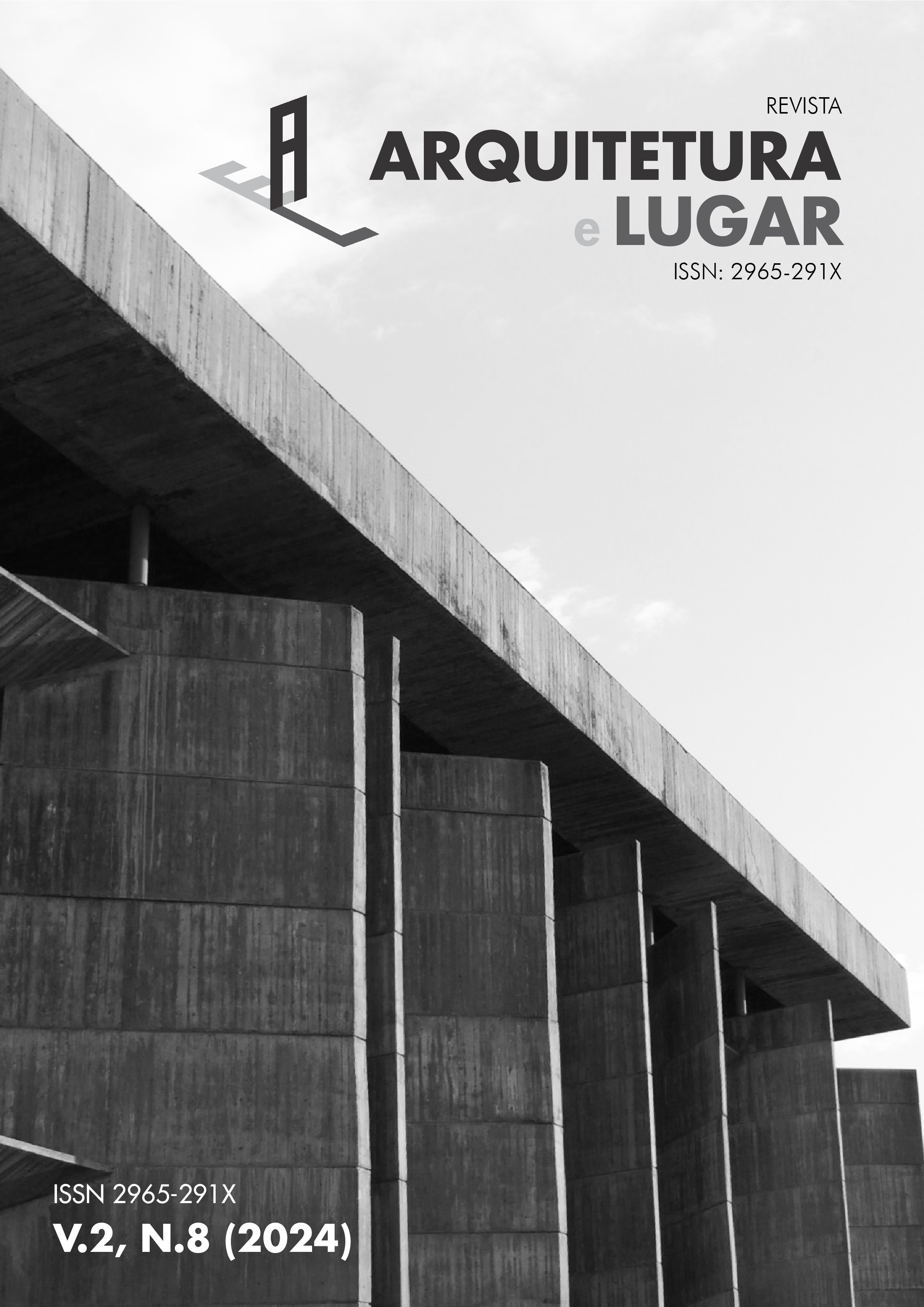A ARQUITETURA DOS BANHEIROS PÚBLICOS E AS LUTAS SOCIAIS
UMA ANÁLISE HISTÓRICA
Keywords:
public restrooms, inclusion, minorities, architecture, accessibilityAbstract
The text will dissect the history of groups that have been marginalized and whose presence is still questioned in the public sphere, through the connection between social struggles and the architecture of public restrooms over the years, starting from the 19th century. Four periods of resistance to the public inclusion of minorities will be analyzed, covering women, black people, and people with disabilities, leading up to the current resistance involving the LGBT community and the discussion about creating a "suitable" third restroom for this group. The goal is to highlight the importance of architecture as an agent of social transformation, through the adaptation of projects to a new typology of gender-neutral restrooms; this typology also encompasses groups of users still not socially recognized, emphasizing a democratic, accessible, and safe solution for social conflicts similar to those throughout history, adapting to contemporary debates.
Downloads
References
ABEL, E. Bathroom doors and drinking fountains: jim crow’s racial symbolic. Critical Inquiry. The University of Chicago Press, v.25, n.3, p. 435-481, 1999. Disponível em:<https://www.jstor.org/stable/1344186?seq=1#metadata_info_tab_contents>. Acesso em: 28 set. 2024.
ANTHONY, K. H. A quiet revolution: women’s public restrooms in America. Bathroom today, n. 2, p. 36-39, mai-set 2006. Disponível em:<https://core.ac.uk/download/pdf/4820945.pdf>. Acesso em: 28 set. 2024.
ANTHONY, K. H.; DUFRESNE, M. Potty privileging in perspective: gender and family issues in planning and designing public restrooms. Journal of Planning Literature. SAGE Publications, v. 21, n. 3, p. 267-294, fev. 2007. Disponível em: <https://journals.sagepub.com/doi/abs/10.1177/0885412206295846>. Acesso em: 27 set. 2024.
BARCAN, R. Dirty Spaces: Separation, Concealment, and Shame in the Public Toilet. In: MOLOTCH, Harvey; NORÉN, Laura. Toilet: public restrooms and the politics of sharing. New York; London: New York University Press, 2010. p. 25-42.
BORIS, E. "You Wouldn't Want One of 'Em Dancing with Your Wife": Racialized Bodies on the Job in World War II. American Quarterly. The Johns Hopkins University Press, v. 50, n. 1, p. 77–108, mar 1998. Disponível em:<https://www.jstor.org/stable/30041600>. Acesso em: 01 out. 2024.
BOVENS, L.; MARCOCI, A. The Gender-Neutral Bathrooms: a new frame and some nudges. Behavioural Public Policy. Cambridge University Press, v. 4, n. 2, p. 1-24, jul. 2020. Disponível em: <https://www.cambridge.org/core/journals/behavioural-public-policy/article/genderneutral-bathroom-a-new-frame-and-some-nudges/C6CDCA42BAEBCE684B243EB9773A771C>. Acesso em: 03 out. 2024.
BRASIL. Lei Nº 13.146, de 6 de jul. de 2015. Lei Brasileira de Inclusão da Pessoa com Deficiência. Brasília, DF: Diário Oficial da União, 2015. Disponível em: <http://www.planalto.gov.br/ccivil03/Ato2015-2018/2015/Lei/L13146.htm>. Acesso em: 30 set. 2024.
BRASIL. Resolução Nº 2, de 19 de set. de 2023. Diário Oficial da União, 2023. Disponível em:< https://abmes.org.br/legislacoes/detalhe/4482/resolucao-cnlgbtqia+-n-2>. Acesso em: 15 out. 2024.
BRECKENRIDGE, C. A.; VOGLER, C. The Critical Limits of Embodiment: Disability’s Criticism. Public Culture. Duke University Press, v. 13, n. 3, p. 349-357, 2001. Disponivel em:<https://read.dukeupress.edu/public-culture/article/13/3/349/31655/The-Critical-Limits-of-Embodiment-Disability-s>. Acesso em 28 set. 2024.
CAMBIAGHI, S. S. Da acessibilidade. In: SETUBAL, Joyce Marquezin (org.); FAYAN, R. A. C. (org.). Lei Brasileira de Inclusão da Pessoa com Deficiência - Comentada. Campinas: Fundação FEAC, 2016. Disponível em:<https://www.feac.org.br/wp-content/uploads/2017/05/Lei-brasileira-de-inclusao-comentada.pdf>. Acesso em: 08 out. 2024.
COLKER, R. Public restrooms: flipping the default rules. Ohio State Law Journal. The Ohio State University, v. 78, n. 1, p. 146-179, 2017. Disponível em:<https://kb.osu.edu/bitstream/handle/1811/81114/1/OSLJ_V78N1_0145.pdf>. Acesso em: 08 out. 2024.
CURVO, I. C.; VALENTE, J. L. Os Banheiros e o Culto de Gênero. In: CONGRESSO DE DIVERSIDADE SEXUAL E DE GÊNERO, 1, 2014, Belo Horizonte. Anais…Belo Horizonte: UFMG, 2014, p. 568-581. Disponível em:<https://anaiscongressodivsex.files.wordpress.com/2015/03/47-isabelle-carvalho_-julia-valente.pdf>. Acesso em: 10 out. 2024.
DUTRA, M. Lei cria normas para banheiros públicos no Rio. O Globo, São Paulo, 28 de mar. 2008. Rio. Disponível em:<https://acervo.oglobo.globo.com/busca/?tipoConteudo=artigo&pagina=&ordenacaoData=relevancia&allwords=banheiros%2C+acessibilidade%2C+lei&anyword=&noword=&exactword=&decadaSelecionada=2000&anoSelecionado=&mesSelecionado=&diaSelecionado=>. Acesso em: 30 set. 2024.
GATTULLI, A. Diseñar en torno al debate: Baños de género neutro. ArchDaily Colombia, 2022. Disponível em:<https://www.archdaily.co/co/984938/disenar-en-torno-al-debate-banos-de-genero-neutro>. Acesso em 10 out. 2024.
GERSHENSON, O. The restroom revolution: unisex toilets and campus politics. In: MOLOTCH, H.; NORÉN, L. Toilet: public restrooms and the politics of sharing. New York; London: New York University Press, 2010, p. 191-207.
IBDFAM – INSTITUTO BRASILEIRO DE DIREITO DE FAMÍLIA. Cerca de 2 em cada 100 brasileiros são transgêneros e não binários, revela pesquisa. Belo Horizonte: IBDFAM, 1 de fev. 2022. Disponível em:<https://ibdfam.org.br/noticias/9307/Cerca+de+2+em+cada+100+brasileiros+s%C3%A3o+transg%C3%AAneros+e+n%C3%A3o+bin%C3%A1rios%2C+revela+pesquisa>. Acesso em: 10 out. 2024.
IBGE – INSTITUTO BRASILEIRO DE GEOGRAFIA E ESTATÍSTICA. Pessoas com deficiência. Rio de Janeiro: IBGE, [entre 2018 e 2023]. Disponível em:<https://educa.ibge.gov.br/jovens/conheca-o-brasil/populacao/20551-pessoas-com-deficiencia.html>. Acesso em: 10 out. 2024.
KOGAN, T. S. Sex separation: the cure-all for victorian social anxiety. In: MOLOTCH, Harvey; NORÉN, Laura. Toilet: public restrooms and the politics of sharing. New York; London: New York University Press, 2010. p. 145-164.
LEITE, M. A. de L. A NBR 9050 e o Design Universal: Um Estudo Sobre o Banheiro. 2016. Dissertação (Mestrado) - Pós-Graduação em Projeto, Morfologia e Tecnologia do Ambiente Construído – Faculdade de Arquitetura e Urbanismo, Universidade Federal do Rio Grande do Norte, Natal, 2016. Disponível em:<https://repositorio.ufrn.br/bitstream/123456789/21566/1/NBR9050DesignUniversal_Leite_2016.pdf>. Acesso em: 28 set. 2024.
LIMEIRA. Projeto de Lei nº 318, de 13 de dezembro de 2021. Proíbe a instalação de banheiros unissex nos estabelecimentos públicos e comerciais no Município de Limeira, e dá outras providências. Limeira: Câmara Municipal, 2021. Disponível em:<http://consulta.limeira.sp.leg.br/Documentos/Documento/268642>. Acesso em 15 out. 2024.
MOORE, S. A. Facility Hostility? Sex Discrimination and Women’s Restrooms in the Workplace. Georgia Law Review, v. 36, n. 599, p.599-603, 2002. Disponível em: <https://heinonline.org/HOL/LandingPage?handle=hein.journals/geolr36&div=21&id=&page=>. Acesso em: 28 de set. 2024.
MOREAU, J. No link between trans-inclusive policies and bathroom safety, study finds. NBC News, 19 de set. 2018. Disponível em:<https://www.nbcnews.com/feature/nbc-out/no-link-between-trans-inclusive-policies-bathroom-safety-study-finds-n911106>. Acesso em: 11 out. 2024.
NATT, E. D. M.; SARAIVA, L. A. S.; CARRIERI, A. de P. Criação de Banheiros LGBTS: inclusão ou prática discriminatória? Revista eletrônica de ciências administrativas (RECADM). Curitiba, v.14, n.1, p. 31-34. jan-abr 2015. Disponível em: <https://www.researchgate.net/publication/322748969_Criacao_de_banheiros_LGBTS_inclusao_ou_pratica_discriminatoria>. Acesso em: 08 out. 2024.
NATIONAL CENTER FOR TRANSGENDER EQUALITY. Transgender People and Bathroom Access. 2016. Disponível em:<https://transequality.org/issues/resources/transgender-people-and-bathroom-access>. Acesso em: 08 out. 2024.
PARADELLA, R. Número de idosos cresce 18% em 5 anos e ultrapassa 30 milhões em 2017. Rio de Janeiro: IBGE, 26 de abr. 2018. Disponível em:<https://agenciadenoticias.ibge.gov.br/agencia-noticias/2012-agencia-de-noticias/noticias/20980-numero-de-idosos-cresce-18-em-5-anos-e-ultrapassa-30-milhoes-em-2017>. Acesso em: 10 out. 2024.
PENNER, B.; GERSHENSON, O. Ladies and gents: public toilets and gender. Philadelphia: TempleUniversity Press, 2009.
PHIRI, G. Women’s rights and the “loo leash”: the fight for public toilets in the UK, Leeds, 13 de jul. 2022. Disponível em:< https://wash.leeds.ac.uk/womens-rights-and-the-loo-leash-the-fight-for-public-toilets-in-the-uk/>. Acesso em: 13 out. 2024.
ROCHA, P. A. M. da. Paulo Mendes da Rocha: “Um dos paradigmas da arquitetura é evitar o desastre”. Entrevista concedida à Angélica de Morais. Revista Cult, São Paulo, v. 218, p. 13-22, nov. 2016. Disponível em:< https://revistacult.uol.com.br/home/paulo-mendes-da-rocha-arquitetura/>. Acesso em 13 out. 2024.
UNITED STATES OF AMERICA. Public Law 101-336, de 26 de julho de 1990. Americans with Disabilities Act of 1990. Washington D.C: Presidential Remarks and Statement, 1990. Disponível em: <https://www.govinfo.gov/content/pkg/STATUTE-104/pdf/STATUTE-104-Pg327.pdf>. Acesso em: 08 out. 2024.
WANG, T. et al. State Anti-Transgender Bathroom Bills Threaten Transgender People’s Health and Participation in Public Life: Policy Brief. Boston: The Fenway Institute, 2016. Disponível em:<https://fenwayhealth.org/wp-content/uploads/2015/12/COM-2485-Transgender-Bathroom-Bill-Brief_v8-pages.pdf>. Acesso em: 11 out. 2024.
WEYENETH, R. R. The Architecture of Racial Segregation: The Challenges of Preserving the Problematical Past. The Public Historian. University of California, v. 27, n. 4, p. 11-44, 2005. Disponível em:<https://www.jstor.org/stable/10.1525/tph.2005.27.4.11>. Acesso em: 28 set. 2024.
WILCOX, J. H.; HAAPALA, K. Why Architects Must Rethink Restroom Design in Schools. Metropolis, 2 de nov. 2016. Disponível em:<https://metropolismag.com/viewpoints/why-architects-must-rethink-restroom-design-in-schools/>. Acesso em: 11 out. 2024.
Downloads
Published
How to Cite
Issue
Section
License
Copyright (c) 2024 Nícia Bezerra Formiga Leite, Ylana Maria Gadelha Pitombeira Furtado

This work is licensed under a Creative Commons Attribution-NonCommercial-NoDerivatives 4.0 International License.
Authors who publish in this journal agree to the following terms:
1. Authors retain the copyright and grant the journal the right of first publication, with the article simultaneously licensed under the Creative Commons Attribution License BY NC ND, which allows the sharing of article with acknowledgment of authorship and initial publication in this journal;
2. Authors are authorized to take additional contracts separately, for non-exclusive distribution of version of the article published in this journal (e.g. publish in institutional repository or as a book chapter), with acknowledgment of authorship and initial publication in this journal;
3. Authors are allowed and encouraged to publish and distribute their research work online (e.g. in institutional repositories or on their personal page) once the editorial process has been completed, as this can generate productive changes, as well as increase the impact and the citation of published article (See The Effect of Open Access);
4. It is not recommended to publish and distribute the article before its publication, as this may interfere with its blind peer review.




